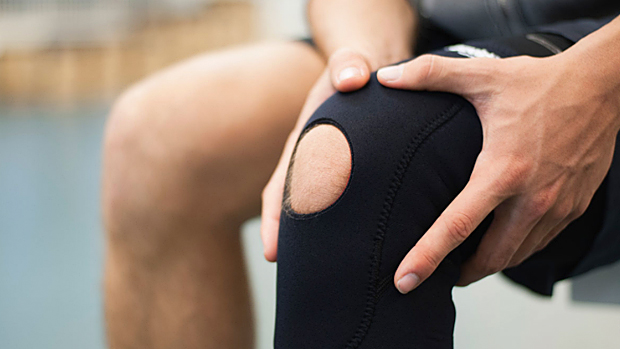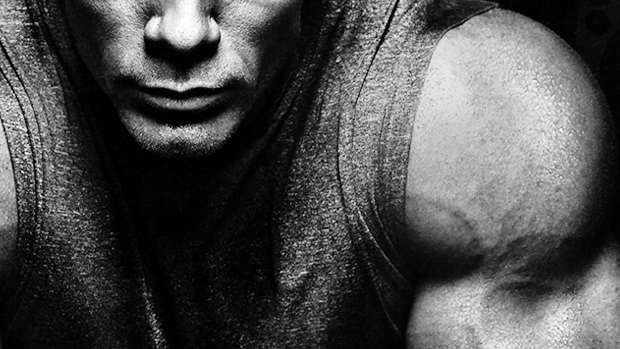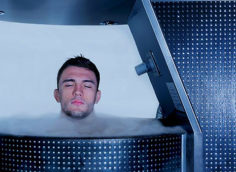Using Your Head(s)
The title should say it all. This isn't an article about triceps kickbacks, isolation exercises, or anything of the sort. The goal of this article is to teach you basic triceps anatomy coupled with the knowledge necessary to design a triceps training program that'll increase your functional strength and power. As an added bonus, we're going to turn those pipe cleaners into pipes!
The triceps are made up of three separate heads: the long, medial, and lateral heads. The primary function of all three is extension of the elbow; however, certain movements hit the triceps heads differently. Below is a brief list of exercises (adapted from the book, Muscle Meets Magnet) that can target the specified muscle head:
Long Head
Lying EZ-bar Triceps Extension
Overhead Dumbbell Extension
Overhead EZ-bar Extension
Medial Head
Close Grip Bench Press
Press Behind Neck
Semi-Supinated Dumbbell Press
Lateral Head
Close Grip Bench Press
Press Behind Neck
Lying Dumbbell Triceps Extension
All Three Heads
Decline EZ-bar Triceps Extension
Parallel Bar Dips
Bench Dips
As you can see, the most triceps movements are largely performed by the medial and lateral heads. The long head is most heavily recruited when it's pre-stretched, such as in exercises where the elbow is overhead (e.g. overhead dumbbell extensions). So, for an example, working the long head may be more necessary for a strongman competitor or someone who does a lot of overhead pressing, where as it may not be as crucial for a powerlifter.
A basic rule of thumb should be this: If it uses more weight, it's probably a more effective exercise. The basis of your program should be heavy movements such as close grip benches, dips, etc.
Old School Ways to Bomb the Triceps
If you walk around "fluffer" gyms today, you see plenty of guys with nice definition in their arms or separation between their delts, triceps, and biceps. These guys can bench press, oh, I'd say about seven pounds. In stark contrast, we're interested in strong, functional triceps, the kind that hang off the back of your arm like slabs of meat.
I can't tell you how many times I've heard people say, "I've done triceps extensions with every attachment possible, but my bench is going nowhere!" These people need to cut the crap and go "old school." If you're interested in improving your bench or overhead-pressing strength, here are just a few ideas to kick-start your progress. I've sub-divided these exercises into pressing-based movements and extension-based movements.
Pressing Based Movements
Pressing based triceps movements are the equivalent of squats for the low body. By employing more muscle groups, you can increase the weight used and therefore increase the stimulus applied to the body. Again, these aren't "isolation" triceps exercises; all of them use the pectorals and shoulder muscles as well. However, these exercises do take the emphasis off the surrounding musculature and make the triceps perform the brunt of the work.
Close-Grip Bench
This, coupled with dips, should be the backbone of any triceps program. The close-grip bench is an excellent exercise because it's very "real world." When you bench press, for example, usually your arms are deviated away from the midline of your body. On the other hand, when you push things in real life, usually your arms are in tight to your body. A great example is a stiff-arm in football. The arm is in close to the body to create the greatest mechanical advantage. Even though you don't lie down in football, a close-grip incline is a great exercise to improve your stiff-arm strength, due to the triceps involvement and pressing angle.
Another great thing about this exercise is that it can be performed in all the variations associated with a bench press. For example, you can do close grip presses on a flat, incline, or decline bench. These options alone allow for a thorough bombardment of your triceps from several different angles.
 |
 |
Dips
Dips are another truly old school way to improve your strength. It seems anything that uses body weight these days is taboo. Exercises like pull-ups, push-ups, and dips have been replaced by trendy new machines that are supposed to replicate the movement pattern. But why replicate a movement pattern you can perform on your own?
Not only are these machines expensive, but they also weren't designed specific to your body type, limb length ratios, strength curve, etc. Last time I checked, you never get to strap in before you push yourself up onto a ledge like you do in a dip machine. So again, this is a "real world" exercise because you're moving your own body weight (and hopefully more weight using a dipping belt or similar!).
A disclaimer for this exercise might be necessary as well: Whereas some coaches recommend extreme ROM (range of motion) where the forearm touches the biceps, I prefer that you lower until your upper arms are parallel to the ground, then return to the top. Going deeper than this – in my opinion – will only cause an increase in shoulder rotation, which could at some point lead to injury. Remember, there are no bad exercises, only bad exercise performance!
 |
Decline Bench Press
While having lost some luster in the last decade, the decline bench press is an excellent movement for increasing triceps strength. If you're a competitive powerlifter, I feel the decline is actually a better assistance exercise than the incline because it mimics the competitive lift more closely. In the decline, your chest is elevated and there's less shoulder rotation due to the angle. This is very similar to the competitive bench press, where the arch causes elevation of the chest and a decreased ROM (e.g. less shoulder rotation).
Here's another reason as to why you should include declines in your program. Think about a military press, which puts the emphasis on the shoulders and hits the triceps at the top. Now envision yourself performing a flat bench, where there are contributions from the pectorals, shoulders, and triceps. Finally, you have the decline, which relies almost solely on pectoral and triceps strength. As the angle of your body decreases, the shoulder recruitment is decreased and the triceps involvement is increased. This is also why people who have shoulder problems can perform decline bench or flat bench with minimal discomfort, while inclines are quite painful.
 |
JM Press
Even though this is a hybrid exercise, I put the JM Press in the pressing category because it definitely isn't a true isolation movement. In essence, you use a narrow grip and lower the bar in a straight line down to about an inch or two off your neck. Now, you rock it back about a half inch, then perform a triceps extension back to the starting position. It's a little funky at first, but the proof is in the pudding. Just consider that the guy it's named after, JM Blakely, has bench pressed 700 pounds!
 |
 |
 |
 |
Extension Based Movements
For lack of a better term, these are the movements that "isolate" the triceps muscles. The main purpose of the triceps muscle is extension of the arm, so that's our goal with our extension-based movements.
Skull Crusher and Throat Crusher (with EZ-curl bar or barbell)
The first option is a fairly well-known exercise. It can be performed with either a barbell or an EZ-curl bar. The EZ-curl variation allows for stress to be taken off the wrists, but both are great exercises and the best option if you're going to do an "isolation" triceps movement.
For the throat crusher, you'll be performing a skull crusher to – you guessed it – your throat! Just avoid actually crushing your windpipe and dying, as this has been shown in many studies to greatly interfere with strength and mass development.
The nice thing about this exercise is that it puts an emphasis on the insertion of the triceps near the elbow. You won't be able to go as heavy on these, but your strength should come around quickly. If you start to tire in the middle of your set, slowly start to work the bar back towards your face with each rep to help you finish the set and really blast the triceps.
You can really kick up the effectiveness of both these exercises by performing them on a decline as well. The decline increases the involvement of all three triceps heads when compared to the basic flat-bench version.
Dumbbell Skull Crusher
This exercise is a nice change of pace, especially since regular skull or throat crushers can impinge people in the elbow area. Couple decreased pain with an increased need to stabilize the weight by using dumbbells and you have a pretty decent accessory exercise.
Overhead Extensions
While I don't think these are as good as skull or throat crushers, overhead extensions have the benefit of really blasting the long head of the triceps. By putting the long head in a stretched position, you're guaranteed to promote some serious soreness if you haven't performed this type of exercise in a while.
Elbows Out Dumbbell Extensions
I'm not sure if they came up with this exercise, but I do know Louie Simmons and Westside have promoted it for quite sometime. On either a flat or incline bench, start with the dumbbells like you're going to do a press. Now, instead of pressing the weights, break at the elbows and keep the ends of the dumbbells pressed together until the weight gets to your chest. Flex the triceps and extend the weight back to the starting position.
Putting it All Together
Now that you have a pretty good idea of what exercises can really help you bring up those tri's, we need to figure out a way to put them into a training program. Ideally, you'll have 48 to 72 hours rest between training sessions to promote recovery and supercompensation.
In my training for powerlifting, I usually perform a heavy bench workout, followed 72 hours later by a bench press assistance workout. Now, how you structure your workouts will determine how you want to lay out your triceps work. I usually strive to get one press-based workout and one extension-based workout in per week. For example, if you bench press heavy on Tuesday then do speed bench work on Friday, you might want to set up your program like this:
Tuesday – Heavy Bench Press Work
Bench Press, 5 x 3 @ 80%
Throat Crushers, 4 x 8
Friday – Speed Bench Workout
Speed Bench, 9 x 3 @ 40%
Close Grip Declines, 5 x 5
With the Tuesday workout, your triceps should be pretty thoroughly smoked after the heavy benching, so you'll finish them off with an extension based exercise. On Friday, the speed bench shouldn't be overly taxing on the triceps, so you can hit them hard and heavy with the close grip work.
Another option is if you don't perform speed work, you can use your Friday workout to really pound your tri's by putting the close-grips first in your training session. This isn't the Weider prioritization principle at work, this is common sense: the exercise you perform first will probably be the best because you're fresh and ready to train. Hit it hard and watch the poundages go up!
Now, here's an example for someone who'd bench heavy on Monday, then do overload type movements such as floor presses, board presses or heavy lockouts on Thursday.
Monday – Bench Workout
Bench Press, 3 x 8 @ 65%
Dips, 4 x 8 (with weight)
Thursday – Bench Press Assistance
3-Board Press, 2 x 2 @ 100% of bench press max
Dumbbell Triceps Extension, 4 x 6
Since the heaviest day this week is Thursday, we'll perform our extension-based movements on that day. Therefore, Monday will be our heavy press-based workout.
The final option is a three day routine for bench press specialists, or those who have extremely good recovery. The rest will be 48 hours on average.
Monday
Bench Press, 4 x 8
Skull Crushers, 4 x 10
Wednesday
Speed Bench, 9 x 3
or
Rack Work, work up to heavy sets of 3
Triceps Pushdown, 3 x 12
Friday
Close Grip Decline, 4 x 8
Dips with weight, 3 x 6
Monday is your standard bench workout, coupled with some accessory triceps work. Wednesday is your speed bench or rack work day, and this is coupled with triceps pushdown. The main purpose of the pushdowns is to get blood into the muscle and prepare the body for the real triceps bombing that will come on Friday. Wednesday's pushdowns shouldn't be max effort, but more to enhance recovery. Finally, Friday will be a true triceps adventure; this is why you'll get 72 hours of rest before your next bench workout on Monday.
Keep in mind that these are just examples; don't treat them as gospel! You know your own body better than anyone. Some lifters' triceps are so weak they may need to actually perform press-based triceps workouts every training day to try and increase strength. Try one of these templates out to see how it works for you.
Conclusion
The workout world is coming full circle. Exercises and muscle groups that have been forgotten in the 80's and 90's are coming back en vogue. Improving your triceps strength creates a synergistic effect that'll also improve your overhead and bench pressing strength. Pick a couple of the aforementioned exercises and take your strength to the next level!




